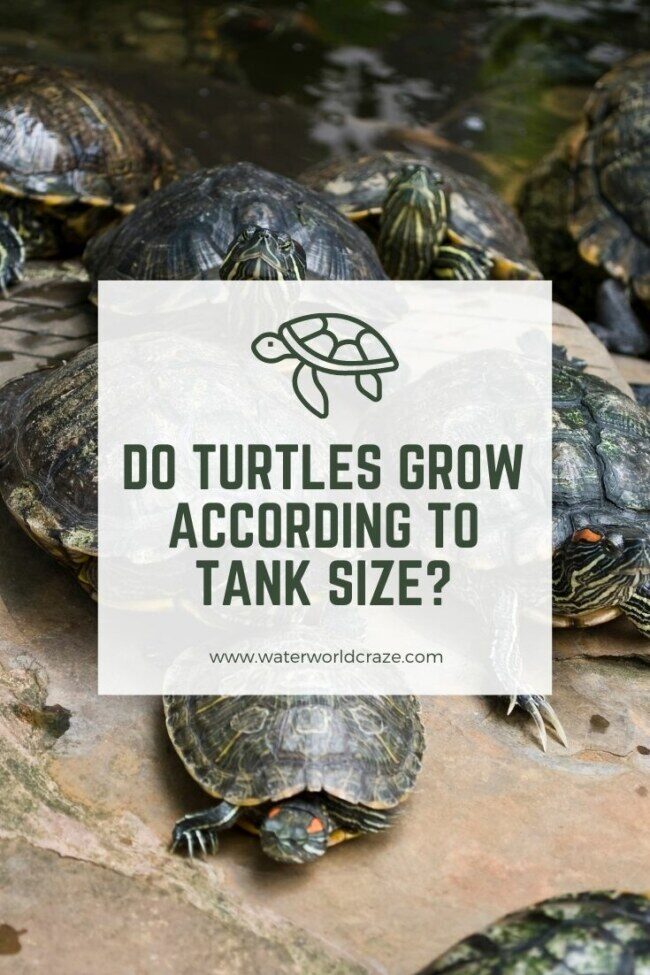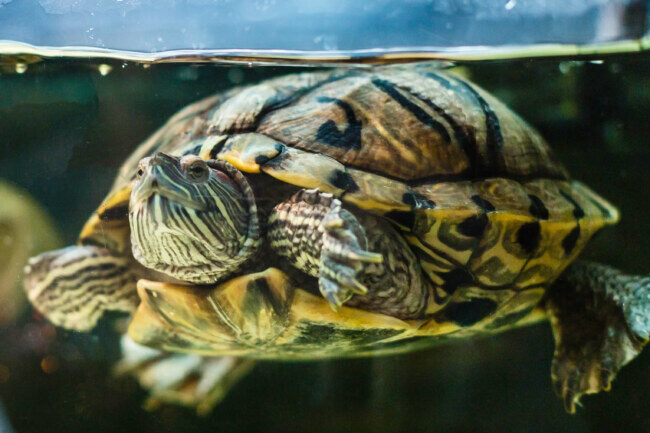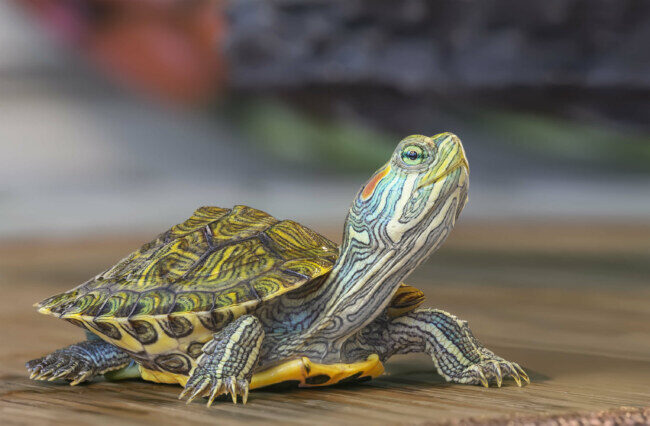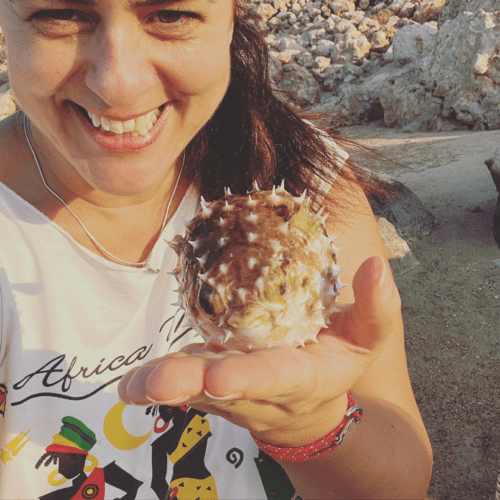
Many factors, for instance, the water temperature and the diet have an impact on your turtle’s growth. However, do turtles grow according to the tank size?
The size of your turtle tank does not directly affect the growth of your pet. Nevertheless, the lack of swimming space and the excessive amount of waste in a small tank can cause stress to your turtle. That will affect other factors that could lead to health problems and stunted growth.
How exactly does tank size influence the growth of your turtle, anyway? What other factors do you need to consider if you want your pet to grow fast? Read this article to find out!
Table of Contents
It Is Not True That Turtles Grow According To Tank Size
The answer to this question is not as simple as it seems. The truth is that a combination of many factors can have an influence on your pet’s growth. One of them can be the size of their habitat.
Turtles have a high growth rate before maturity. Under the right conditions, most species grow rapidly in the first five years of their development.
A turtle may continue growing despite a small turtle tank or habitat. However, that’s highly unlikely because tank size usually affects other factors which influence the pet’s growth, such as swimming space, stress, and health.
Additionally, your choice of turtle species is important. Although cute baby turtles are often born the same size, some species grow up to 12 inches while others stay smaller than 5 inches.
Therefore, each turtle needs the best care, depending on its species. If you provide the same tank size and amount of food to a Red-Eared-Slider (12 inches) and a Common Musk turtle (4.5 inches), your slider probably won’t be able to reach its full size. Yes, you will save some money on the food and the turtle tank.
However, you will negatively affect your pet’s health. Providing a large, diverse habitat to your turtle, on the other hand, will keep it fit and happy.
Who created the myth that turtles grow according to tank size?
Unethical pet sellers want to convince you to buy a pet at any cost, even though you can’t afford to take care of it. Hearing that a turtle will grow only as much as its habitat allows, makes you take an easy decision – you can get a pet and spend less.
Some pet sellers also keep a lot of turtles in a small enclosure for the same reason – to save money. They make their clients believe that wild turtles live comfortably in packs.
However, aquatic turtles are solitary animals and keeping them in a tiny space might lead to fights for territory.

What will happen if a turtle lives in a small tank long-term?
Small tank means more waste
Small tanks accumulate waste quickly. Even with proper filtration and circulation of the water, toxic ammonia and nitrites will pollute your pet’s habitat.
When ammonia has reached toxic levels in the tank, aquatic animals like fish and turtles can’t extract energy from their food efficiently. As a result, their growth rate can decrease. A too high concentration of ammonia might even become lethal for your pet.
Stress and less room for swimming
If you chose a too-small tank for your pet turtle, you would reduce its swimming space. Since aquatic turtles usually live in oceans, they require a lot of room for swimming to grow happy and healthy.
Additionally, a small tank limits the opportunity for introducing stones, aquatic plants, and fish into your turtle’s tank to make your pet’s habitat more natural.
Poor environmental conditions and lack of space could lead to chronic stress for your turtle. Just like all other animals, turtles become less active and try to hide while they are stressed.
Stress weakens the immune system. That doesn’t only make your turtle more susceptible to infection but will also slow down its metabolism and growth.
Fight for territory
If you are looking after several turtles in the same tank, providing a small enclosure is a really bad idea! The lack of room will cause competition over food and basking area.
Since turtles already have an aggressive nature, the stress in a cramped habitat space will make them even more violent against each other.
Fighting and territorialism might cause injuries that will make your pets more susceptible to diseases. If the turtle’s health is threatened, their growth will slow down.
Is it possible that a turtle would become bigger if it had a huge habitat?
A huge tank alone will not change the growth rate of your turtle. What your pet needs is a balanced lifestyle to develop to its full potential.
One step to that is creating a large and diverse habitat. That will prevent stress, fights for territory, and diseases. As a result, your turtle will reach its expected size at a normal pace.

What affects your turtle’s growth?
There are two important factors that have an influence on your turtle’s growth that you have no control over:
- Genetics: The average full-grown adult size of aquatic turtles depends on the species because they have different genetic traits. For instance, the red-eared slider can grow up to 12 inches (30,5 cm). The common musk turtle, on the other hand, is only 4,5 inches (11,5 cm) long.
- Gender of the turtle: Depending on the species, size may vary between males and females. Female red-eared sliders, for example, grow larger than males and reach up to 10-13 inches (25-33 cm). Males are between 8-10 inches (20-25 cm).
However, there are a few details that you can take care of, if you want your turtle to grow steadily and be healthy.
Right temperature of the water and the basking area
Turtles are ectothermic. That means that they acquire heat from the environment to maintain their body temperature.
You can regulate the temperature better in a larger tank since there will be enough space for swimming and a basking area. Setting up a basking area will help the turtle grow faster.
Drying off and UV-rays exposure will speed up their digestion and will prevent infections that might slow down growth.
Usually, the water temperature should be close to the air temperature, so between 75-85°F (23.9-29.4°C). The basking area, on the other hand, should be warmer so the turtle can dry. We recommend a range from 85-95°F (23.9-35°C).
Diet
Make a feeding schedule with a list of foods that will prove beneficial for your pet. Younger turtles enjoy a high protein diet. As your pet gets older, you can add more fruits and vegetables to its meal plan.
If there is enough nutrition in the food, your turtle will receive the required amount of Calcium and Vitamin D. That will keep its growth stable and make its carapace strong. In a small tank, food will not be evenly distributed. Leftover food will create a lot of waste.
Keeping track of the turtle’s size
If you get a baby pet turtle, you will be able to follow its growth. Record your turtle’s measurements over a few weeks.
Turtles that are looked after correctly should grow rapidly, and consistently until they reach maturity. Afterwards, their growth will slow down.
Our tip: If you want your pet to be happy, choose a tank size for a fully-grown turtle. Buying a tank based on the size of a baby turtle will only make your life hard – you will have to upgrade constantly as your pet grows.
If you want to find out how to calculate the perfect tank size for your turtle, keep on reading this article!
How to determine the right tank size?
As we already mentioned, every turtle species has a different average size. However, each one of them needs enough space to swim, explore and bask. To find the right tank size, you can use the rule of thumb.
A turtle needs 10 gallons (45 litres) of water per inch (2,5 cm) of carapace length. It’s a good idea to inform yourself about the size of the turtle species in a fully grown stage. In the table below, you can see an overview of the general size guidelines.
| Average adult size | Example species | Tank size |
| Small 4-6 inches (10-15 cm) |
Common musk turtle (4.5 inches), Bog Turtle (3-4 inches), Reeve’s Turtle (6 inches) |
40 – 60 gallons (181 – 273 liters) |
| Medium 6-8 inches (15-21 cm) |
Painted turtle (7+ inches), Yellow-Bellied Slider (8 inches), Eastern Box Turtle (8 inches) |
60 – 80 gallons (273 – 364 liters) |
| Large 8+ inches (21+ cm) |
Red-Eared Slider (up to 12 inches), African Sideneck Turtle (12 inches), Wood Turtle (9 inches) | 80+ gallons (364+ liters) |
Summary
The tank size doesn’t directly affect your turtle’s growth. However, a small enclosure might lead to more waste in the tank and inefficient extraction of energy from food.
If you have more than one turtle, the lack of room might cause stress, violence and competition for space and food.
To make sure your turtle grows healthy, you need to choose the right temperature in its habitat and create a healthy food plan. Additionally, you can research the average adult size of your turtle’s species and choose the right size of enclosure for it.

Marta, the driving force behind WaterWorldCraze.com, holds a Master’s degree in Marine Biology and has extensive experience in water sports and activities. With over 7+ years of hands-on experience in marine research and conservation, she has participated in numerous underwater expeditions and projects. Her passion for the aquatic world shines through in her expertly curated content. Join Marta as she explores the wonders of marine life and shares her adventures. Connect with her on Instagram @marinebiologymarta for more insights and updates.

